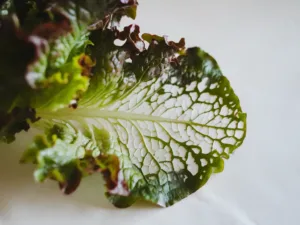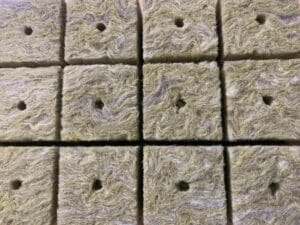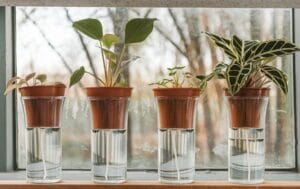Why Sunflower Microgreens?
Sunflower microgreens aren’t just pretty to look at—they’re true superfoods! These small, crunchy sprouts are full of nutrients essential for a healthy diet. They’re rich in vitamins, minerals, and antioxidants, making them a perfect addition to salads, sandwiches, or as a garnish. Their slightly nutty taste adds an interesting flavor to many dishes. Growing sunflower microgreens is also a quick and easy way to produce fresh greens that you can enjoy year-round. So, if you’re looking for a new challenge in hydroponics, sunflower microgreens are the perfect choice!
The Best Varieties for Sunflower Microgreens
Not all sunflowers are the same when it comes to growing microgreens. Some varieties are particularly well-suited, as they develop robust shoots and tasty leaves. Here are the best varieties for sunflower microgreens:
- Black Oil Sunflower: This variety is the classic choice for microgreens. It has dark, almost black seed shells and produces thick, sturdy shoots. Its flavor is especially intense and slightly nutty—a real treat!
- Grey Stripe Sunflower: Also very popular for microgreen cultivation, this variety has striped seeds and produces milder shoots than the black oil sunflower. The sprouts are often especially juicy.
- Mammoth Grey Stripe: A large-growing variety that also thrives as a microgreen. It delivers especially large and juicy sprouts that look very decorative on a plate.
Your choice of variety depends on your personal taste and desired harvest time. Black oil sunflowers tend to germinate a bit faster, while striped varieties are milder in flavor. Both options add variety to your kitchen!
The Ideal Growing System for Sunflower Microgreens: Substrate Mats Instead of Hydroponics
Sunflower microgreens have specific needs when it comes to their growing system. While many plants thrive in traditional hydroponic systems like NFT (Nutrient Film Technique) or Deep Water Culture (DWC), these methods are less suitable for microgreens. Why? Microgreens are sown densely and harvested as young, tender shoots. Their roots need a stable surface to hold onto and grow, which most hydroponic systems don’t provide.
This is where substrate mats come in. These mats, made from materials like hemp, coconut, or jute, provide young roots with the necessary support and moisture they need. The water and nutrients are distributed evenly through the mat, promoting even germination and healthy growth. Substrate mats offer several advantages:
- Optimal Moisture: The mats store water and release it slowly to the plants, which is especially important during the germination phase.
- Good Ventilation: They allow good airflow to the roots, preventing waterlogging and mold growth.
- Easy Handling: After harvesting, the mats can be easily removed and replaced, making maintenance simple.
Growing Sunflower Microgreens: Step-by-Step Guide
Growing sunflower microgreens is a relatively simple process that quickly yields great results with some preparation and the right materials. Here’s a step-by-step guide to help you get started:
- Prepare the Seeds: Start by soaking the sunflower seeds in water overnight. Soaking promotes germination and leads to faster, more even development of the microgreens.
- Prepare the Substrate Mat: Place the substrate mat (e.g., made of hemp or coconut) in a shallow seed tray or dish. Moisten the mat well with water until it is evenly damp. Be careful to avoid puddles.
- Sowing: Spread the soaked sunflower seeds densely over the moist substrate mat. The seeds should not overlap but be close enough to cover the entire area. Press the seeds down lightly to ensure good contact with the mat.
- Cover and Germinate: Cover the seeds with a light film or lid to maintain moisture. For the first 2-3 days, the seeds should germinate in darkness to encourage strong and straight shoots.
- Start the Light Phase: Once the seedlings are 2-3 cm tall, remove the cover and place the tray in a bright spot. Avoid direct sunlight, as strong light can burn the delicate leaves. LED grow lights are ideal for providing even, gentle lighting.
- Water Regularly: Keep the substrate mat consistently moist but not wet. It’s best to water from below by adding water to the tray and allowing the mat to absorb it. This keeps the leaves dry and reduces the risk of mold.
- Harvest: After about 7-10 days, when the cotyledons are fully developed, and the shoots have grown to 10-15 cm in height, the microgreens are ready for harvest. Cut them just above the substrate mat with a sharp pair of scissors.
The Best Substrate for Sunflower Microgreens
Choosing the right substrate is crucial for successful sunflower microgreens cultivation. Here are the best substrate mats for microgreens:
| Substrate Type | Advantages | Disadvantages |
|---|---|---|
| Hemp Mats | Natural fibers, good water retention, biodegradable | Can be prone to mold if poorly ventilated |
| Coconut Mats | Excellent water retention, highly sustainable | Can become overly wet if improperly handled |
| Jute Mats | Good ventilation, biodegradable | Not always readily available, somewhat more expensive |
For sunflower microgreens, hemp and coconut mats are often the top choices. They provide a good balance of water retention and air circulation and are environmentally friendly.
Optimal Conditions: Temperature, Light, and Humidity
To ensure your sunflower microgreens thrive, they need the right environmental conditions. Here are the key parameters:
- Temperature: A consistent temperature between 18-22°C is ideal. Higher temperatures can speed up growth but also increase the risk of mold.
- Light: At least 12 hours of light per day is ideal. LED grow lights are the best choice, as they offer a broad spectrum and are energy-efficient.
- Humidity: A humidity level of 50-60% is ideal for microgreens. High humidity can encourage mold, while low humidity can dry out the plants.
pH Value and EC Value: Key Parameters for Water
The pH and electrical conductivity (EC) of the water are also crucial for healthy plant growth:
- pH Value: Keep the pH between 5.5 and 6.5 to ensure optimal nutrient uptake.
- EC Value: The EC should be around 1.0-1.5 mS/cm. High salt concentrations can damage the young roots.
The Right Nutrients for Sunflower Microgreens
While sunflower microgreens primarily draw nutrients from the seeds, additional nutrients in the water can help produce stronger shoots. Use a special microgreen fertilizer tailored to the needs of young plants. Ensure that the nutrient solution is not too concentrated to avoid burning the delicate roots.
Harvest and Storage: When and How to Harvest Sunflower Microgreens
The perfect time for harvest is when the microgreens have fully developed their cotyledons and reached a height of around 10-15 cm. Harvest them with a clean pair of scissors, cutting just above the substrate mat. Freshly harvested, they can last in the refrigerator for about 5-7 days. Only wash the microgreens before storage if they are to be used immediately to prevent mold.
Diseases and Pests: Prevention and Control
Mold is a common issue when growing microgreens. To prevent mold, make sure your growing conditions are optimal—good airflow, moderate humidity, and no standing water. If pests appear, neem oil sprays or natural pest control products can help.
Tips and Tricks for Successfully Growing Sunflower Microgreens
- Avoid Overcrowding: Seeds that are too closely spaced can hinder each other’s growth and encourage mold.
- Reuse the Cuttings: The harvested shoots can be used as nutrient-rich mulch.
- Experiment with Lighting: Different light colors (red, blue) can influence growth. Experiment to find your ideal light source.
Sunflower Microgreens – Small but Mighty!
Sunflower microgreens are a fantastic way to bring fresh, healthy greens into your kitchen. They are nutritious, fast-growing, and easy to cultivate. With proper care and the right substrate mats, you can soon enjoy your own nutty-sweet microgreens right at home. What are you waiting for? Get started and harvest your own sunflower microgreens!







